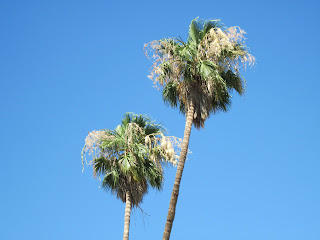We have finally learned, through hard experience, that the best time to see most of Arizona, starts about the end of September and extends until the end of April. Summer can be nice above 5,000 feet but even at altitude the winter is the best time to see Arizona. Any day that there are clouds and a storm is a good day to see the Grand Canyon. Even if you have to hold onto a tree to keep from being blown away. The views are decidedly more dramatic and impressive.
Now don't get me wrong. I don't mind the heat at all. I grew up before air conditioning. I was in my last year in high school before we moved into a house with air conditioning. I didn't have a car with air conditioning until I was married and had several children.
When you live in Phoenix it is easy to avoid the heat almost entirely. You go from your air conditioned car, to air conditioned homes and businesses and only go outside when it is absolutely necessary. There is also the almost universally present swimming pool. There are dozens of public pools and tens of thousands of private swimming pools.
Then there are those who have to be outside in the heat. All of the service and support people whose jobs require outside work. You see them cutting grass, digging, building and walking. No one who doesn't have to be outside, is out on the streets. Usually, except for the cars, the neighborhoods and streets look deserted. One time I came home from living my summer on the Colorado Plateau and found the house full of water. This was before air conditioning. One of the toilets had run and flooded almost the entire house. It was probably 110+ outside and inside and with the water, the humidity was nearly 100%. I had to move all of the water soaked books and stuff outside and clear out all the water. That was the hottest I ever remember being in my life.
When you have to go outside and stay for a while, you begin to notice that 100 degrees is not that hot. They (whoever they are?) always joke about Arizona having a dry heat. Well, dry or hot, once the temperature gets above 110 degrees, the air is hot. If you are driving in a car and the temperature is around 100 degrees, you can put your hand out the window and feel a little bit of cooler air. But if it is 110 or higher, the air feels hot and actually feels like it is burning your hand.
During this hot summer, it helps to remind yourself of cool mountains and rain, even snow. Although, most of the time when I think of snow during the summer in Phoenix, I have a really hard time believing that it really exists. One summer, we loaded all the children in the car and I said we were driving north until it got cold. We kept driving until we reached Jasper National Park where we had frost on our tent when we woke up camping next to the Columbia Ice Field.
When you live in Phoenix it is easy to avoid the heat almost entirely. You go from your air conditioned car, to air conditioned homes and businesses and only go outside when it is absolutely necessary. There is also the almost universally present swimming pool. There are dozens of public pools and tens of thousands of private swimming pools.
Then there are those who have to be outside in the heat. All of the service and support people whose jobs require outside work. You see them cutting grass, digging, building and walking. No one who doesn't have to be outside, is out on the streets. Usually, except for the cars, the neighborhoods and streets look deserted. One time I came home from living my summer on the Colorado Plateau and found the house full of water. This was before air conditioning. One of the toilets had run and flooded almost the entire house. It was probably 110+ outside and inside and with the water, the humidity was nearly 100%. I had to move all of the water soaked books and stuff outside and clear out all the water. That was the hottest I ever remember being in my life.
When you have to go outside and stay for a while, you begin to notice that 100 degrees is not that hot. They (whoever they are?) always joke about Arizona having a dry heat. Well, dry or hot, once the temperature gets above 110 degrees, the air is hot. If you are driving in a car and the temperature is around 100 degrees, you can put your hand out the window and feel a little bit of cooler air. But if it is 110 or higher, the air feels hot and actually feels like it is burning your hand.
During this hot summer, it helps to remind yourself of cool mountains and rain, even snow. Although, most of the time when I think of snow during the summer in Phoenix, I have a really hard time believing that it really exists. One summer, we loaded all the children in the car and I said we were driving north until it got cold. We kept driving until we reached Jasper National Park where we had frost on our tent when we woke up camping next to the Columbia Ice Field.













